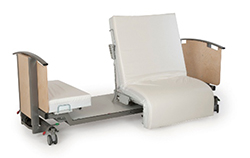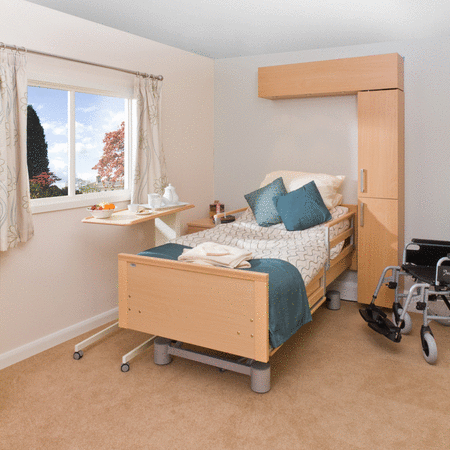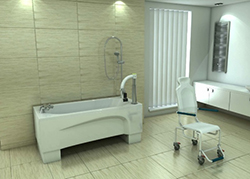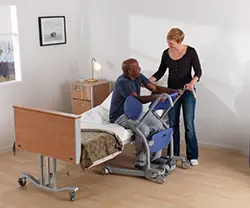
Disability and independence: the tricky business of transferring
Frances Leckie, editor of Independent Living, looks at some of the challenges around transferring and personal dignity.
#DHgurus
My day job over at Independent Living often sees me writing about equipment and techniques for “moving and handling people”. If you are on the receiving end, needing some help to make the move from bed to chair, onto the toilet, into the shower, or perhaps into your car, I suspect that the way such transfers are achieved makes quite a difference to how you feel about your day. So I am not totally surprised at the strong feelings provoked by the subject.
Perhaps the very phrase “moving and handling people” indicates a slightly mechanistic approach by some care professionals, and there does, at first glance, seem to be a divergence of opinion along the lines of those doing the transferring, and those being moved. The former – understandably and sensibly – very concerned about protecting themselves from back injury, and the latter more focused on comfort and dignity. I prefer to think of the procedure as a collaboration, with the safety and well-being of both parties properly protected.
Are hoists inherently undignified?
My latest research into possible new developments in the field came about when we received a letter from somebody asking for help with transfer aids. She was unable to participate in the transfer in any way, but wouldn’t countenance the use of transfer sheets because she found them dangerous, or hoists because they were “undignified”. To be honest, this left us in rather a quandary about what to suggest, apart from a transfer board/handling belt combination, which didn’t feel like the most comprehensive answer to the many situations where a person might need to move from one piece of equipment to another.
Bearing in mind that people reading this article will come in a range of different physical abilities, I thought it might be interesting to look at what is available for transferring people who can and can’t contribute to the process.
Independence to start the day

Getting to and from bed is a big deal – and as budgets are squeezed, and many people find themselves with fewer hours of care available to them, equipment that can make this transfer possible independently can be invaluable. Rotating chair beds, which take you from lying down to sitting up maybe the answer for some: in addition to the normal profiling and height adjustment facilities you would expect from a care bed, these turn the lying surface to the left or right, while lifting and bending from horizontal to chair-shape. If you can weight bear, you should then be able to transfer into your wheelchair unaided. Or with the variable height facility, the chair can help you into a standing position For anyone who does need assistance, the rotating chair bed may still be a practical alternative to hoisting.

If you need a hoist to get you in and out of bed, and your aesthetic sense is offended by the sight of it, you will probably love the Integralift, which is completely concealed when not in use. The lift tucks away in a wall-mounted cabinet – which can be part of a stylish bed head or even a bookcase – and is easy to swing out into position when it is needed.
In and out of the bath seamlessly

A soak in the bath is a therapeutic experience for most of us, but maybe not accessible if you aren’t independently mobile. Transferring into the tub can be accomplished more easily with one of the new generation of assisted baths that incorporate a powered chair to lift you up over the rim and down into the water. Some, like the Syncra system shown here use the same chair on a wheeled base to transfer from bedroom to bathroom.
Standing transfers preferred?

There is a degree of consensus that standing transfer aids are the most dignified option – provided you are able to support your weight for at least a short time. Amongst these, there are models like the Rotunda which are intended simply to transfer from one seated position to another, and those such as the Sara Stedy which can be used for transport over short distances as well. If you are able to use this sort of aid, there are also health benefits to be derived from standing up, such as improving muscle and bone strength, digestive function and circulation. Some standing aids are designed to be used as a support for physical therapy, enabling the user to exercise safely in an upright position.
Dedicated solutions for motoring

Maybe it’s not surprising, given the central role of a car in maintaining independence, that there seem to be more possibilities for getting in and out of vehicles than anything else! If you don’t have a WAV (wheelchair accessible vehicle) which you can drive from your powerchair, having driven yourself into it by means of powered ramp, then other options include powered swivelling car seats that will come out to meet you, so that you can transfer from your wheelchair; transfer seats which bridge the gap between car seat and wheelchair, making it easier to get from one to the other; or a dedicated hoist which is fitted in the car and lifts you out of the wheelchair into the vehicle. There are various options for stowing a wheelchair in the car, as well, including those such as the Abiloader, which collect and deliver the chair at the driver’s door, allowing you to travel alone, without having to worry about getting your wheelchair in and out of the boot.
What do you think about assisted transfers?
Finally, many people professed themselves completely happy to be transferred using a hoist – generally a ceiling track hoist, rather than the mobile type that is propelled along the floor. The difference between a transfer that inspires confidence, and leaves the transferree feeling comfortable and dignified, and one that brings fear and pain or discomfort, seems to be proper training and mental attitude. If PAs or carers have been well trained in using hoists (or any other equipment for that matter) and regard their client as a partner in the procedure, rather than the passive recipient of their attentions, then all should be well. Perhaps everybody should experience being hoisted several times before doing it to anyone else? Do you have any other ideas about improving transfers? Or opinions about equipment that is or isn’t dignified? You can add your comments here, and share your views with the DH community.
By Frances Leckie
Get in touch by messaging us on Facebook, tweeting us @DHorizons, emailing us at editor@disabilityhorizons.com or leaving your comments below.